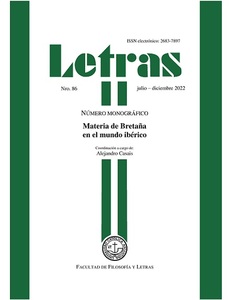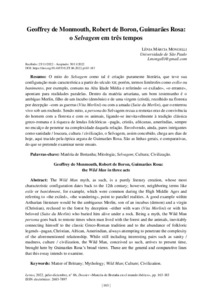Please use this identifier to cite or link to this item:
https://repositorio.uca.edu.ar/handle/123456789/16328| Título: | Geoffrey de Monmouth, Robert de Boron, Guimarães Rosa: o Selvagem em três tempos Geoffrey de Monmouth, Robert de Boron, Guimarães Rosa: the Wild Man in three acts |
Autor: | Mongelli, Lênia Márcia | Palabras clave: | MITOLOGIA; HOMBRE SALVAJE; CULTURA; CIVILIZACION; LITERATURA MEDIEVAL; PERSONAJES | Fecha de publicación: | 2022 | Editorial: | Pontificia Universidad Católica Argentina. Facultad de Filosofía y Letras | Cita: | Mongelli, L. M. Geoffrey de Monmouth, Robert de Boron, Guimarães Rosa: o Selvagem em três tempos [en línea]. Letras. 2022, (86). doi:10.46553/LET.86.2022.p163-183. Disponible en: https://repositorio.uca.edu.ar/handle/123456789/16328 | Resumen: | Resumo: O mito do Selvagem como tal é criação puramente literária, que teve sua
configuração mais característica a partir do século XII; porém, termos limítrofes como exílio ou
banimento, por exemplo, comuns na Alta Idade Média e referindo «o exilado», «o errante»,
apontam para realidades paralelas. Dentro da matéria arturiana, um bom testemunho é o
ambíguo Merlin, filho de um íncubo (demônio) e de uma virgem (cristã), recolhido na floresta
por decepção –com as guerras (Vita Merlini) ou com a amada (Suite du Merlin), que o enterrou
vivo sob um rochedo. Sendo mito, a persona do Selvagem recua a remotas eras de convivência
do homem com a floresta e com os animais, ligando-se inevitavelmente à tradição clássica
greco-romana e à riqueza de lendas folclóricas –pagãs, cristãs, africanas, ameríndias, sempre
no encalço de penetrar na complexidade daquela relação. Envolvendo, ainda, pares intrigantes
como sanidade / loucura, cultura / civilização, o Selvagem, assim concebido, chega aos dias de
hoje, aqui trazido pela óptica arguta de Guimarães Rosa. São as linhas gerais, e comparativas,
do que se pretende examinar neste ensaio. Abstract: The Wild Man myth, as such, is a purely literary creation, whose most characteristic configuration dates back to the 12th century; however, neighboring terms like exile or banishment, for example, which were common during the High Middle Ages and referring to «the exiled», «the wandering», point to parallel realities. A good example within Arthurian literature would be the ambiguous Merlin, son of an incubus (demon) and a virgin (Christian), reclused to the forest by deception –either with wars (Vita Merlini) or with his beloved (Suite du Merlin) who buried him alive under a rock. Being a myth, the Wild Man persona goes back to remote times when man lived with the forest and the animals, inevitably connecting himself to the classic Greco-Roman tradition and to the abundance of folkloric legends –pagan, Christian, African, Amerindian, always attempting to penetrate the complexity of the aforementioned relationship. While still including interesting pairs such as sanity / madness, culture / civilization, the Wild Man, conceived as such, arrives to present time, brought here by Guimarães Rosa’s broad views. These are the general and comparative lines that this essay intends to examine. |
URI: | https://repositorio.uca.edu.ar/handle/123456789/16328 | ISSN: | 0326-3363 (impreso) 2683-7897 (online) |
Disciplina: | LITERATURA | DOI: | 10.46553/LET.86.2022.p163-183 | Derechos: | Acceso abierto | Fuente: | Letras No.86, Materia de Bretaña en el mundo ibérico, 2022 |
| Appears in Collections: | LETRAS - 2022 nro. 86 - Materia de Bretaña en el mundo ibérico |
Files in This Item:
| File | Description | Size | Format | |
|---|---|---|---|---|
| cover_issue_471_es_AR.jpg | 39,23 kB | JPEG |  View/Open | |
| geoffrey-monmouth-robert.pdf | 426,28 kB | Adobe PDF |  View/Open |
Page view(s)
37
checked on Apr 27, 2024
Download(s)
21
checked on Apr 27, 2024
Google ScholarTM
Check
Altmetric
Altmetric
This item is licensed under a Creative Commons License

